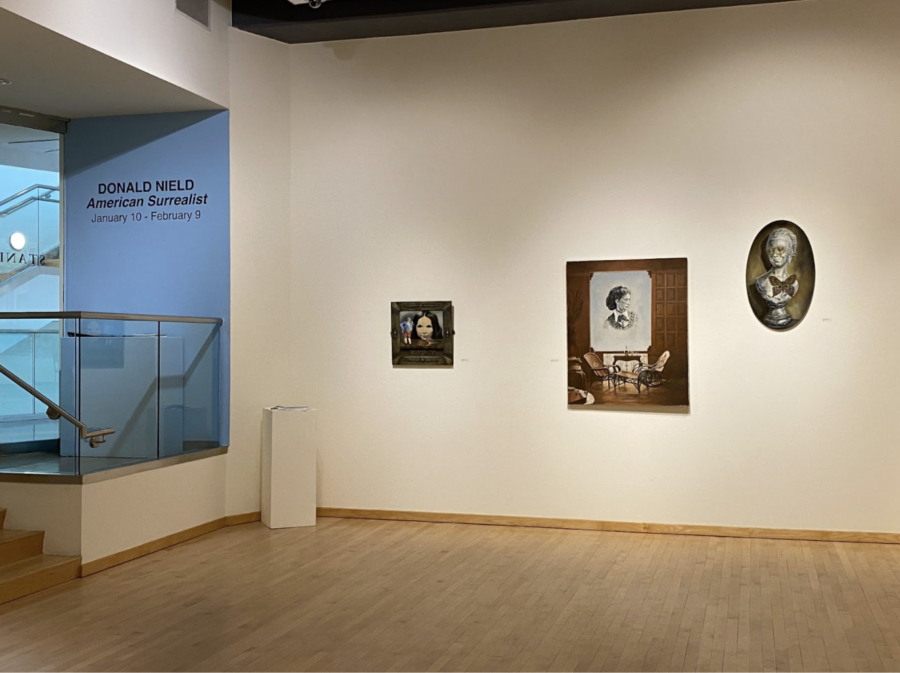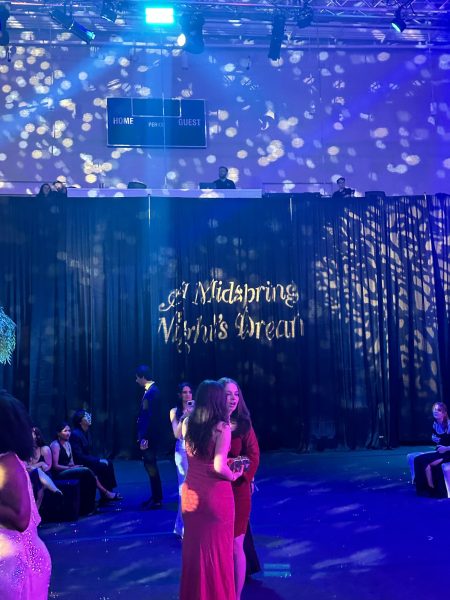Staniar exhibit explores the definition of surrealism
American artist Donald Nield’s works merge Old Master painting, surrealism and pop art styles
“Donald Nield: American Surrealist” will be on display in Staniar Gallery from Jan. 10 to Feb. 9.
February 1, 2022
Elliott King, professor of art history, gave a lecture on surrealism through the lens of artist Donald Nield on Jan. 18. Nield’s paintings are featured in Staniar Gallery’s “Donald Nield: American Surrealist” exhibit from Jan. 10 until Feb. 9.
This exhibition is only the second solo showing of Nield’s artwork. His first solo exhibition occurred at Roanoke College in September 2021, 34 years after his death.
The exhibition was titled “Coming of the Great Fish,” in reference to a piece depicting a fish larger than a whale flying through the sky.
Born in Shanghai, Nield spent his early life living abroad in the United Kingdom, Canada and China before his mother remarried an American businessman and moved their family to the United States.
Through his stepfather’s business connections, a young Nield was commissioned to produce commercial advertisements in line with the American pop art movement.
Nield’s development as an artist continued in conjunction with his studies in anatomy and perspective at The Art Students League of New York, which boasts alumni such as Jackson Pollock, Norman Rockwell, Georgia O’Keeffe and Washington and Lee alumnus Cy Twombly, ’53.
It was there that he was exposed to, and became opposed to, art centered around abstraction.
Nield’s oil paintings instead became characterized by photorealism and “quotes” from Old Masters, diverging from the American abstraction movement that surrounded him.
Nield took an interest in the philosophical thought of his time, which inspired his participation in surrealism. According to King, surrealist ideas relied heavily on the psychoanalytic theories of Sigmund Freud and the 12 archetypes described by Carl Jung.
With this in mind, King encouraged attendees to consider Nield’s identity as a surrealist beyond the unusual or bizarre quality of his works, and instead as an identity firmly rooted in Nield’s understanding and exploration of new surrealist perceptions of the human mind.
“Surrealism is a process of listening to an inner need,” King said. “If we consider Freud’s iceberg model of the human mind, there exists the unconscious mind – our irrational wishes, unacceptable sexual desires, shameful experiences and selfish needs.”
Surrealism plays to those wishes and needs, he said, and “we are able to observe all of this and more in Nield’s works.”
King went on to discuss the relationships that Nield had with the works of other well-established surrealists of his time, such as Dali and Magritte, and his trend of quoting, or the practice of borrowing subject matter, characters or scenes, from these works.
However, King took care to highlight the artistic uniqueness of Nield’s work.
“These are incredibly theatrical pieces, and the narrative is your own creation,” King said. “Nield also encourages and rewards close examination with his details.”
Art history major and medieval and renaissance studies minor Elyssa McMaster, ’22, reflected on Nield’s take on surrealism.
“Nield’s references are both obvious and subtle,” McMaster said. “I especially liked Nield’s references to classical and medieval artwork with angel statues in contemporary American landscapes.”
She also shared her thoughts on how relevant Nield and his works are in telling the story of the surrealist movement.
“Surrealists in Europe were quite picky about who could or couldn’t be in their group, so the title ‘American Surrealist’ applies so well to the show,” she said. “Nield’s work with different real-life elements makes his work feel more like something my brain would have made up, too.”
With the newfound interest in Nield’s work and the opening of two solo exhibitions within the span of a few months, both King and McMaster said they believe Nield will continue to become more relevant to the canon of surrealism.













